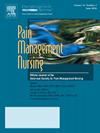Pharmacogenetic Associations with Hospitalization Frequency in Black Adolescents & Young Adults with Sickle Cell Disease
IF 1.6
4区 医学
Q2 NURSING
引用次数: 0
Abstract
Acute pain of abrupt onset and severe intensity is the hallmark of Sickle Cell Disease (SCD). Approximately 100,000 Black Americans have SCD; but a small subset has a disproportionate number of hospitalizations for acute vaso-occlusive crisis (VOC) pain. Their increased hospitalization frequency is associated with high opioid analgesic use, and higher risk of early death. The burden of SCD-related pain worsens, and chronic pain develops as adolescents age to become adults. We hypothesize that Black Adolescents & Young Adults (AYAs) with SCD who require frequent hospitalizations for acute VOC pain have a greater prevalence of significant pharmacogenetic pain variants (genotypes) that influence pain severity and opioid analgesic effects (phenotype).
The purpose of this study is to determine if there are significant pharmacogenetic associations with hospitalization frequency in a cohort of 45 Black AYAs with SCD.
In this prospective exploratory study, a commercial pharmacogenomics panel was used to determine prevalence of 8 highly polymorphic genes that may influence analgesic effects. Here we report the association of the number of hospitalizations 12 months prior to study enrollment and pharmacogenetic results from 45 Black AYAs with SCD. These are initial results from a larger study of pain variants (genetics of pain susceptibility, pain sensitivity & pharmacogenetics) from Black AYAs with SCD.
Results: CYP2B6, CYP2C8, CYP2C9, CYP2C19, CYP2D6, COMT, OPRM1, and SLC64A genotypes were obtained from 45 Black AYAs with SCD, (Mean & Median age = 15 years, Range 10-23) who had 0 to 21 (Mean 2, SD 4, Median 1) hospitalizations for VOC in the 12 months prior to obtaining genotypes. There was no correlation between age and number of hospitalizations. Frequent hospitalizations (>3 in past year) was also not associated with genotypes. Prevalence of CYP2B6, CYP2C19, CYP2D6, COMT, OPRM1, and SLC64A was not significantly different than reference population, but significantly more patients were CYP2C9 intermediate metabolizers (p<.001). Clinical implications will be presented of how pharmacogenetic testing for might improve clinical care for individual patients will be presented.
Implications for future research: Larger sample size and exploratory analysis of pain susceptibility & sensitivity genotype and gene expression are needed to advance precision pain management in this vulnerable population.
求助全文
约1分钟内获得全文
求助全文
来源期刊

Pain Management Nursing
医学-护理
CiteScore
3.00
自引率
5.90%
发文量
187
审稿时长
>12 weeks
期刊介绍:
This peer-reviewed journal offers a unique focus on the realm of pain management as it applies to nursing. Original and review articles from experts in the field offer key insights in the areas of clinical practice, advocacy, education, administration, and research. Additional features include practice guidelines and pharmacology updates.
 求助内容:
求助内容: 应助结果提醒方式:
应助结果提醒方式:


